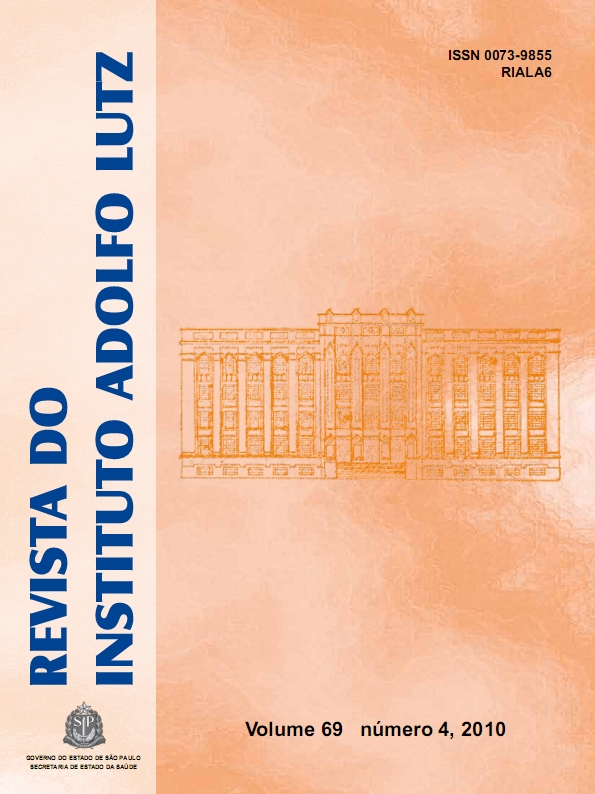Resumo
A gelatina foi preparada da pele de tilápia (Oreochromis niloticus) e suas propriedades reológicas foram determinadas. A avaliação da força de gel da gelatina foi realizada por meio de analisador de textura, modelo TA-XTplus e a viscosidade foi determinada por meio de viscosímetro Ostwald-Fensk. As propriedades viscoelásticas foram estimadas em reômetro Rheostress Haake RS-150. Com o tempo de maturação de 18±1h, a força de gel e a viscosidade apresentaram valores, respectivamente, de 243±7,55g e 5,24±0,29cP. O prolongamento do tempo de maturação ocasionou aumento de força de gel e viscosidade. Os pontos de fusão e de formação de gel foram, respectivamente, de 27º e 22,5ºC, e o processo resultou em rendimento de 8,85±1,80%. A gelatina de pele de tilápia possui propriedades reológicas intermediárias àquelas descritas na literatura para gelatinas originárias de outros pescados.Referências
1. Simon A, Vandanjon L, Levesque G, Bourseau P. Concentration and desalination of fish gelatin by ultrafiltration and continuous diafiltration processes. Desalinat. 2000; 144: 313-8.
2. Schott A. Functions of gelatine in food applications. Am Assoc Cereal Chemists, Inc. 2001; 46: 414-6.
3. Gilsenan PM, Ross-Murphy SB. Rheological characterisation of gelatins from mammalian and marine sources. Food Hydrocoll. 2000; 14: 191–5.
4. Muyonga JH, Cole CGB, Duodu KG. Extraction and physico-chemical characterisation of Nile perch (Lates niloticus) skin and bone gelatin. Food Hydrocoll. 2004; 18: 581–92.
5. Gudmundsson M, Hafsteinsson H. Gelatin from cod skins as affected by chemical treatments. J Food Sci. 1997; 62: 37–9.
6. Choi SS, Regenstein JM. Physicochemical and sensory characteristics of fish gelatin. J Food Sci. 2000; 65: 194–9.
7. Jamilah B, Harvinder KG. Properties of gelatins from skins of fish: black tilápia(Oreochromis mossambicus) and red tilápia(Oreochromis nilotica). FoodChem. 2002; 77: 81–4.
8. Cho SM, Gu YS, Kim SB. Extracting optimization and physical properties of yellowfin tuna (Thunnus albacares) skin gelatin compared to mammalian gelatins. Food Hydrocoll. 2004; 19: 221-9.
9. Fernandez-Díaz MD, Montero P, Gómez-Guillén MC. Effect of freezing fish skins on molecular and rheological properties of extracted gelatin. Food Hydrocoll. 2003; 17: 281-6.
10. Grossman S, Bergman M, inventores. Process for the production of gelatin from fish skins. US Patent 5,093,474. 1992 Mar 3.
11. Alfaro AT. Otimização das condições de extração e caracterização da gelatina de pele de tilápia (Oreochromis urolepis hornorum). [Tese de doutorado]. Pelotas: Universidade Federal de Pelotas; 2008.
12. Association of Official Agricultural Chemist’s International - AOAC. Official Methods of the Association of Official Agricultural Chemist’s International. 17th ed., Gaithersburg: AOAC International; 2000.
13. British Standards Institution – BSI. Methods for sampling and testing gelatin (physical and chemical methods). London; 1975.
14. Eastoe JE, Leach AA. Chemical constitution of gelatin. In: Ward AG, Courts A. organizadores. The science and technology of gelatin. London: Academic Press; 1977. p. 73-108.
15. Gudmundsson M. Rheological properties of fish gelatin. J Food Sci. 2002; 67: 2172-6.
16. Haug IJ, Draget KI, Smidsrod O. Physical and rheological properties of fish gelatin compared to mammalian gelatin. Food Hydrocoll. 2004; 18: 203–13.
17. Jones NR. Uses of gelatin in edible products. In: Ward AG, Courts A. organizadores. The science and technology of gelatin. London: Academic Press; 1977. p. 365-94.
18. Holzer D, inventor. Gelatin production. US Patent 5,484,888; 1996 jan 16.
19.Zhou P, Regenstein JM. Effects of alkaline and acid pretreatments on Alaska Pollock skin gelatin extraction. J Food Sci. 2005; 70: 392–6.
20. Gómez-Guillén MC, Turnay J, Fernandez-Díaz MD, Ulmo N, Lizarbe M, Montero P. Structural and physical properties of gelatin extracted from different marine species: a comparative study. Food Hydrocoll. 2002; 16: 25-34.
21. Johnston-Banks FA. Gelatin. In: Harris P. organizador. Food gels. London: Elservier Applied Science; 1990. p. 233–89.
22. Kolodziejska I, Kaczorowski K, Piotrowska B, Sadowska M. Modification of the properties of gelatin from skins of Baltic cod (Gadus morhua) with transglutaminase. Food Chem. 2003; 86(2): 203-9.
23. Arnesen JA, Gildberg A. Extraction and characterization of gelatine from Atlantic salmon (Salmo salar). Bioresource Technol. 2007; 98: 53-7.
24. Alfaro AT, Costa CS, Prentice C. Propiedades reológicas, estructurales y físico-químicas de gelatina de huesos de pescadilla (Macrodon ancylodon) sometidos a tratamiento ácido preliminar. Alimentaria. 2005; 367: 66-73.
25. Montero P, Fernandez-Díaz MD, Gómez-Guillén MC. Characterization of gelatin gels induced by high pressure. Food Hydrocoll. 2002; 16: 197-205.
26. Alfaro AT, Fonseca GG, Costa CS, Prentice C. Effect of extraction parameters on the properties of gelatin from King weakfish (Macrodon ancylodon) bones. Food Sci Technol Int. 2009; 15: 553-62.
27. Cole CGB. Gelatin Food Science. [acesso 19 set 2009] Disponível em: [http://www.gelatin.co.za].
28. Wainewright FW. Physical tests for gelatin and gelatin products. In: Ward AG, Courts A. organizadores. The science and technology of gelatin. London: Academic Press; 1977. p. 508-57.

Este trabalho está licenciado sob uma licença Creative Commons Attribution 4.0 International License.
Copyright (c) 2010 Alexandre da Trindade Alfaro, Edilson Ferreira da Silva
